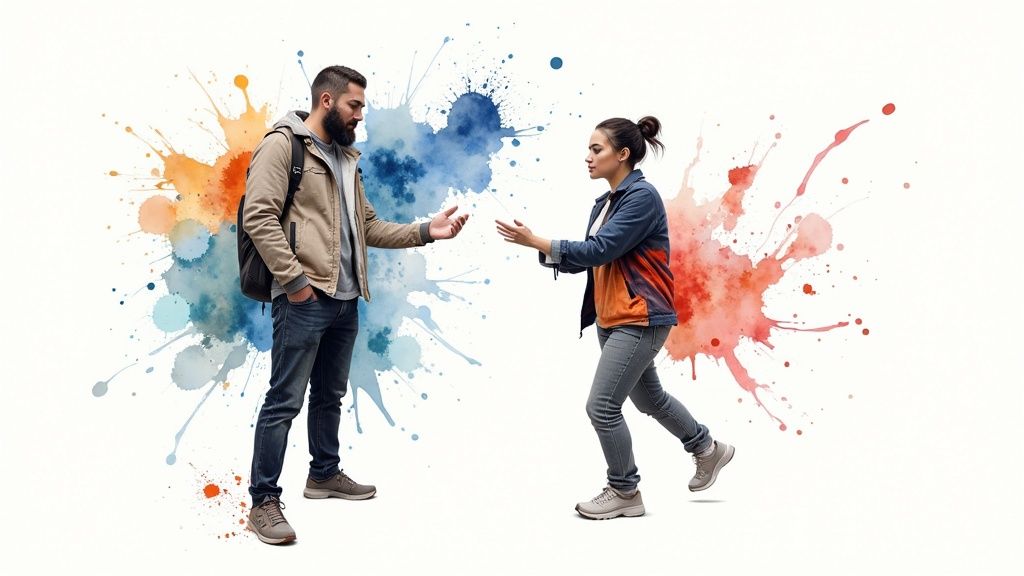Understanding AI's Real Impact on Modern Advertising

When it comes to AI in advertising, there's a lot of discussion about its potential. But what concrete results is it delivering today? The numbers tell a compelling story - the AI marketing sector is on track to reach $36 billion by 2024, with AI-influenced ad spending projected to hit $370 billion. These figures reflect how AI is moving beyond basic automation to drive real business outcomes through data-driven insights and enhanced creative capabilities.
How AI is Delivering Real ROI in Advertising
AI is proving its value through measurable campaign improvements. The technology analyzes massive datasets to pinpoint ideal audiences, forecast performance, and make real-time bidding adjustments. This precise targeting consistently leads to better click-through rates and conversions. For instance, AI tools now generate multiple versions of ad copy and visuals customized for different platforms and audience segments. This allows advertisers to test creative elements at scale, gaining clear data on what messaging works best with their target viewers. The result? Campaigns that reach more people and drive stronger engagement.
Navigating the Challenges of AI Implementation
Despite its benefits, bringing AI into advertising operations isn't always smooth sailing. Many marketing teams still struggle with implementation details. A major hurdle is the knowledge gap - numerous advertising professionals admit they don't fully grasp AI tools and their applications, highlighting the need for more training. Another common mistake is letting AI run on autopilot without human guidance. While AI excels at data processing and optimization, human creativity and strategic thinking remain essential. The most successful agencies find a balanced approach, using AI to support and enhance human capabilities rather than replace them. These teams develop the skills to interpret AI insights and apply them thoughtfully to align with brand goals while maintaining authentic connections with audiences.
The Future of AI and Human Creativity in Advertising
As we look ahead, success in advertising will come from blending AI capabilities with human insight. AI will keep advancing in its ability to automate routine tasks, process data, and fine-tune campaign performance. But human skills like strategic planning, creative problem-solving, and emotional understanding will stay crucial. This partnership between AI and human creativity opens new possibilities for advertisers to build more personal, engaging, and effective campaigns. By taking a strategic approach to AI adoption and fostering ongoing skill development, advertising teams can make the most of AI's strengths while preserving the human elements that make great advertising resonate.
Breaking the AI Implementation Barrier

Many advertising professionals recognize AI's immense potential but struggle to effectively implement it in their daily work. Recent studies show that only 11% feel confident using AI tools - not because they resist change, but because they face real challenges in adoption. These range from practical concerns like selecting and integrating the right tools to deeper issues like helping teams adapt to new workflows. For most agencies, AI's benefits remain just out of reach due to these implementation hurdles.
Overcoming Team Resistance and Fostering AI Literacy
The human element often presents the biggest challenge when introducing AI tools. Team members who excel at traditional advertising methods may worry about job security or feel overwhelmed by new technology. The key is showing how AI complements and enhances their existing skills rather than replacing them. For instance, when teams see how AI can handle tedious tasks like data entry or basic image editing, they can focus more on strategic planning and creative work. Real-world success stories from other agencies also help build confidence. Organizations that invest in comprehensive AI training see results - 52% report major improvements in their teams' AI capabilities within months.
Choosing the Right AI Tools and Building a Culture of Innovation
Finding the right AI tools requires carefully matching solutions to your agency's specific needs and workflows. Different teams need different capabilities - some may focus on generating ad copy, while others need help with media buying or campaign analytics. But having great tools isn't enough. Success comes from creating an environment where teams feel empowered to experiment and learn from both successes and setbacks. Regular check-ins, open discussion of challenges, and celebrating small wins help build momentum. Teams can then continuously refine their AI usage based on real campaign results and insights. Learn more in our article about The Top 10 AI Implementations of 2024 in Media and Marketing.
From Literacy to Mastery: A Step-by-Step Approach
Building AI expertise takes time and should follow a clear progression. Start with basic workshops that explain key concepts in plain language. Then move to hands-on training with tools relevant to each team's daily work. Have team members practice with real campaign scenarios to build confidence. Support ongoing learning through mentorship, online resources, and industry events. This steady progression helps teams not just use AI tools, but understand how to integrate them strategically into campaigns. Regular practice and peer support turn initial uncertainty into growing mastery, positioning teams to get consistently better results from AI over time.
Maximizing Campaign Performance Through AI Optimization

AI in advertising has evolved well beyond basic task automation. Modern agencies are discovering how AI-powered optimization can deliver measurable improvements in campaign results. This shift enables marketers to take a data-driven, proactive approach rather than just reacting to campaign metrics after the fact.
Real-Time Budget Allocation and Bidding
Smart budget allocation is one of AI's most practical applications in advertising today. AI systems can continuously monitor performance across platforms and automatically adjust spending to get the best returns. For instance, if ads on one channel start to underperform, the system quickly moves budget to better-performing options. This responsive approach helps ensure every dollar spent delivers maximum impact. AI-driven bidding also gives advertisers an edge in real-time auctions by optimizing bid amounts based on historical performance data, leading to better conversion rates at lower costs.
Automated A/B Testing and Campaign Adjustments
AI has transformed how advertisers approach A/B testing. What used to require weeks of manual testing can now happen automatically across multiple creative versions and audience segments. The AI analyzes performance data in real-time and suggests specific improvements to targeting, ad placement, and creative elements. This ongoing optimization process helps campaigns stay effective throughout their entire run while providing valuable insights about what resonates with different audience groups.
Case Study: The ASA's AI Monitoring System
The Advertising Standards Authority (ASA) demonstrates AI's real-world impact through their Active Ad Monitoring system. This AI-powered platform is set to analyze over 10 million ads in 2024, more than triple the 3 million reviewed last year. The system quickly flags potentially misleading content, helping maintain industry standards and accountability. This advancement shows how AI can improve both campaign effectiveness and advertising integrity.
Achieving Efficiency While Maintaining Brand Authenticity
While AI delivers impressive efficiency gains, some marketers worry about losing authentic brand connections. However, leading agencies have found that AI enhances rather than replaces human creativity. By handling routine optimization tasks, AI allows marketing teams to focus on strategy and creative development. The results speak for themselves - top performers report up to 47% better campaign efficiency while maintaining consistent brand messaging and audience engagement. This shows how AI and human expertise can work together effectively, driving both performance gains and meaningful audience connections.
Generative AI for Creative Excellence
AI's role in advertising goes far beyond basic automation of campaign management. It's now shaping how creative teams develop compelling content and campaigns. With generative AI tools, marketing teams can produce high-quality creative assets more efficiently, giving them more time to focus on strategy and refining their brand message.
AI-Generated Content in Practice
Generative AI brings speed and versatility to every stage of creative development. During initial concepting, these tools can quickly generate multiple creative directions from a simple prompt. For example, if a team needs visuals for a "winter warmth" campaign, AI can instantly produce dozens of cozy scenes, seasonal landscapes, and product shots - giving creatives a rich foundation to build from. This rapid ideation helps teams explore more possibilities in less time.
The same tools excel at producing customized ad copy for different audiences and channels. Teams can generate variations that highlight specific product features, promotions, or emotional appeals for each demographic and platform - whether that's Instagram, email, or display ads. This ability to efficiently create personalized content at scale gives brands a real advantage in reaching fragmented audiences.
Balancing AI and Brand Identity
While AI offers exciting creative possibilities, maintaining consistent brand voice is essential. Teams need clear processes to ensure AI-generated content aligns with brand guidelines and messaging. This often involves training AI models using existing marketing materials so they learn the unique characteristics of the brand's communication style. The goal is for AI to produce content that authentically represents the brand's identity. You might be interested in: Revolutionizing Advertising: Unleashing the Power of AI Ad Creative.
It's also important to view AI as a creative collaborator rather than a replacement for human creativity. While AI can generate impressive content, human insight and judgment remain crucial for developing compelling narratives that truly connect with audiences. The most successful approaches combine AI's capabilities with human creative vision and strategic thinking.
Measuring AI Creative Performance
Like any advertising initiative, tracking the impact of AI-generated content through metrics is key. Teams should monitor KPIs like click-through rates, conversions, and engagement to assess how well the AI content performs. This data helps refine AI strategies and training to continuously improve output quality. Recent studies show that about 45% of companies are now using or exploring generative AI, with many seeing notable gains in creative productivity. By thoughtfully combining AI tools with human creativity and strategic direction, marketing teams can achieve stronger results while working more efficiently.
Learning From Cross-Industry AI Success Stories

As AI adoption accelerates in advertising, looking at success stories from retail and finance offers valuable insights for advertising teams. By examining how other industries have effectively implemented AI, advertising professionals can better understand both the technical aspects and organizational changes needed for success. Key questions emerge around building internal expertise, managing implementation challenges, and measuring results - all critical factors for advertising teams working to achieve similar wins with AI.
Retail: Personalized Targeting and Enhanced Customer Experience
Major retailers have mastered using AI to create highly personalized shopping experiences. Their AI systems analyze customer behavior data, purchase histories, and preferences to segment audiences with remarkable accuracy. This precise targeting has led to impressive results - some retail leaders have seen a 73% improvement in their targeting accuracy. Beyond just driving sales, this personalization builds stronger customer relationships. Retail's AI success extends to customer service too, where AI chatbots handle routine inquiries, allowing staff to focus on complex customer needs.
Finance: Fraud Detection and Risk Management
Financial services companies have found different but equally powerful applications for AI, particularly in security and risk assessment. Their AI systems scan transactions in real-time to catch fraud attempts before they succeed, protecting both the institution and its customers. AI has also revolutionized lending by analyzing more data points than traditional methods could handle, leading to better risk assessment and loan decisions. Some financial firms have achieved 54% better campaign performance through AI-optimized loan targeting. These results show how AI can both improve operational efficiency and deliver more accurate outcomes.
Adapting Cross-Industry Learnings to Advertising
The retail and finance sectors offer clear lessons that advertising can apply today. Retail's success with data-driven personalization translates directly to creating more targeted ad campaigns. You might be interested in: Inside Coca-Cola's AI Christmas Ad: The Game-Changing Holiday Campaign. Similarly, the testing and optimization methods used in finance can help advertising teams improve their campaign performance and ROI. But success requires more than just implementing new technology. Advertising teams need to build AI knowledge throughout their organization and create a culture that embraces testing and learning. This means investing in training programs, developing clear AI strategies, and creating strong systems to measure results. By learning from other industries' experiences - both successes and challenges - advertising teams can more effectively use AI to improve their campaigns and stay competitive.
Building a Future-Proof AI Advertising Strategy
AI is reshaping how we approach advertising, opening up new possibilities for campaign performance and creative work. For advertisers today, developing a strong AI strategy isn't optional - it's essential for staying competitive. This means going beyond just using AI tools and taking a thoughtful, integrated approach across your entire advertising program.
Key Pillars of a Successful AI Advertising Strategy
Creating an effective AI advertising strategy requires focusing on several core elements:
-
Data Foundation: Start by establishing solid data practices - collecting quality data, ensuring privacy compliance, and building systems to analyze it effectively. Good data allows AI systems to learn and generate meaningful insights.
-
AI Literacy and Skill Development: Your team needs the right knowledge to succeed with AI. Focus on training that covers AI fundamentals, practical applications in advertising, and how to interpret AI-driven insights.
-
Strategic Tool Selection: Choose AI tools that match your specific needs and goals. Consider your budget, team capabilities, and how tools will work with your current processes. The solutions you pick should directly address your key challenges in areas like creative development, media buying, and campaign optimization.
-
Human-AI Collaboration: Remember that AI works best when enhancing human creativity and strategic thinking, not replacing it. Find the right balance - let AI handle routine tasks while your team focuses on high-level strategy, creative development, and building authentic connections with customers.
-
Continuous Optimization: Regularly review how your AI initiatives are performing and make improvements based on the data. Set clear KPIs and track them carefully. For example, if AI-powered bidding isn't meeting targets, adjust your bidding strategies or targeting parameters.
Building Your AI Roadmap: A Step-by-Step Guide
Here's a practical approach to implementing AI in your advertising:
-
Assessment: Look at your current advertising operations and identify where AI could make the biggest impact, whether that's audience targeting, creative work, or campaign optimization.
-
Pilot Projects: Test AI tools on a small scale first. This helps you learn what works before making bigger commitments. You might try an AI copywriting tool for one campaign segment, for instance.
-
Integration: Gradually bring successful AI tools into your regular workflows. Make sure data flows smoothly between systems and provide ongoing support to help your team adapt. This might involve connecting your CRM to an AI personalization platform.
-
Scaling and Refinement: Once pilot projects prove successful, expand them across your advertising operations. Keep monitoring results and adjusting your approach. If an AI image generator works well, for example, you can start using it in more campaigns.
The Future of AI in Advertising: Preparing for What's Next
AI in advertising keeps evolving. Here's what to watch for:
-
Generative AI's Growth: As generative AI gets better at creating content, focus on using it while maintaining your brand's unique voice and authenticity.
-
More Personal Experiences: AI will enable more precise targeting and personalization. This means getting better at using customer data responsibly.
-
New Digital Spaces: As virtual and augmented reality grow, AI will help create engaging experiences in these new environments. Start exploring how to adapt your advertising approach for these platforms.
By building on these fundamentals and staying flexible as technology changes, you can create an AI advertising strategy that delivers results now and adapts for the future. This forward-thinking approach helps improve your campaigns while positioning your organization to lead in AI-powered advertising.
Ready to transform your video content creation and scale your publishing efforts? Aeon, an AI-powered video creation platform, empowers publishers to efficiently produce engaging videos from text, video, or audio content. Learn more and explore the future of video content creation at https://www.project-aeon.com.